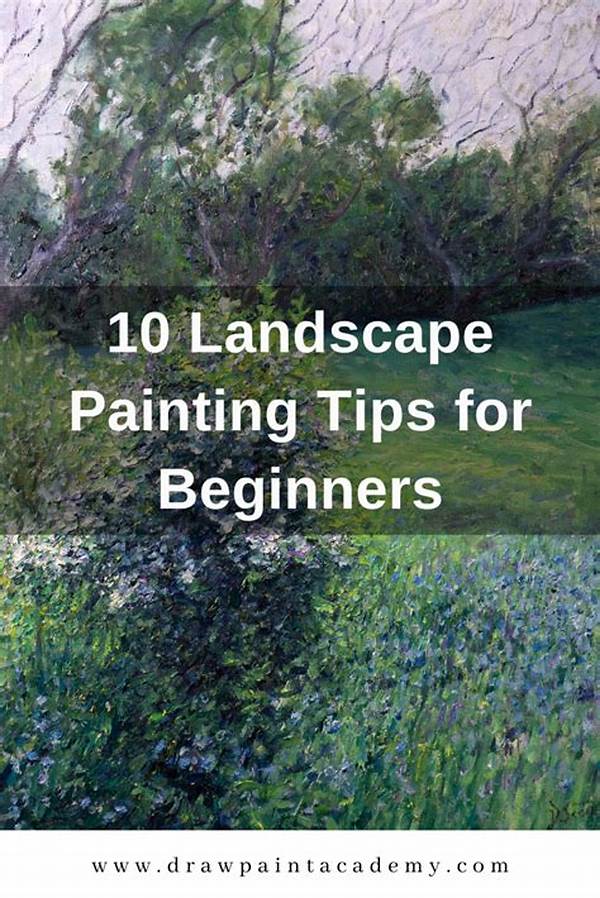On a sunny afternoon, the gentle breeze playing a soft symphony with the leaves, Emily set out for the open fields, her heart fluttering with anticipation. An old satchel hung from her shoulder, filled with brushes, canvases, and vibrant tubes of paint. This was her first attempt at capturing the serene beauty of nature—a new adventure in painting landscapes. As she settled beneath a sprawling oak, the distant hills painted a perfect picture against the cerulean sky. This would be her muse.
Read Now : Local Artisan Market Event
Understanding the Basics of Landscape Painting
That day, Emily realized the importance of selecting the right scene. As a beginner, one of the best landscape painting tips for beginners is to pick a subject that speaks to you. Standing in nature’s embrace, Emily’s eyes darted from the towering oak beside her to the golden fields stretching endlessly. Her mentor had once told her, “A good painting starts with a heartfelt connection to your subject.”
With her heart aligned to the scene, Emily began sketching. The contours of the rolling hills, the embrace of shadows and light—they all wove a story that she wanted to tell. Her strokes were hesitant at first, a reflection of her nervous excitement. But with each line, her confidence grew. In that moment, she understood the value of practice and patience, key components in landscape painting tips for beginners.
Five Essential Tips for Aspiring Landscape Artists
1. Embrace Your Environment
Emily realized that to truly capture the spirit of the landscape, one must become a part of it. Feeling the wind, observing the play of light and shadow, all contribute to a more authentic painting.
2. Choose Your Palette Wisely
She learned that selecting the right colors was crucial. Keeping it simple helped her focus on capturing the essence without being overwhelmed—a vital landscape painting tip for beginners.
3. Start with Simple Compositions
Instead of tackling a complex scene, Emily found success in starting with simpler compositions. This allowed her to grow her skills gradually while appreciating the beauty in minimalism.
4. Focus on Light and Shadow
The dance of sunlight across the fields became Emily’s fascination. Emphasizing these elements gave her paintings depth and life—a staple in landscape painting tips for beginners.
5. Don’t Fear Mistakes
Read Now : Installation Art Immersive Experiences Today
Her greatest lesson was to embrace mistakes as stepping stones in her journey. Each error taught her something new, making her a more resilient artist over time.
Tools and Techniques to Enhance Your Skills
Emily’s journey unveiled the tools that became her allies. Her brushes, each suited for different strokes, became an extension of her hand. A well-chosen canvas provided the perfect stage for her art, and paints, vibrant and rich, gave life to her imagination. These tools were not just things; they were companions on her artistic quest.
In terms of techniques, Emily learned to layer her paints, allowing each coat to tell a part of the story, much like the layers of earth in the fields before her. Each brushstroke was a whisper of the landscape’s secrets, a communication between her and the land. Through trial and error, and a bit of guidance, Emily discovered that altering perspectives could change not just the view in her painting but also the emotional tone—a pivotal point in landscape painting tips for beginners.
Unique Challenges and How to Overcome Them
Throughout Emily’s artistic endeavor, challenges were plentiful. One day, a sudden gust of wind swept her easel off balance, smudging her beautiful hues. But rather than despair, she found a way to incorporate this accident into her canvas. The imperfections lent character to her work, echoing the unpredictable nature of true landscapes. This experience taught Emily one of the most invaluable landscape painting tips for beginners: to adapt and evolve with their art.
Unexpected rain forced her to stop midway, the droplets turning her work into a wash of colors. Instead of lamenting the loss, Emily saw this as a natural blending, a serendipitous collaboration with nature. She adapted to the environment, understanding that as much as she was painting it, the landscape was also painting her. Each challenge became a stepping stone, a part of her growth and a deepening of her artistic dialogue with nature.
Cultivating Patience and Persistence
Emily’s story is a testament to patience and persistence. Each painting session became a meditation, requiring her to slow down, observe, and feel. As a novice, mastering the art of landscape painting wasn’t about swift success but about the gradual refinement of her craft. This journey of persistence, with all its highs and lows, reflects quintessential landscape painting tips for beginners—never rush the process.
In those quiet moments alone with her easel, under the canopy of the endless sky, Emily understood the value of taking her time. Each brushstroke was intentional, a harmonious blend of her vision and the nature before her. This dance with patience allowed her to see beyond the immediate challenges, fostering resilience and igniting her creative spirit. Every painting became not just an artwork but a chapter of personal growth.
Finding Your Unique Style
As Emily continued to paint, she discovered her unique voice in art. Her brush seemed to dance differently, translating her emotions into strokes and hues, rendering landscapes that were distinctly hers. This is one of the landscape painting tips for beginners she cherishes: to find and refine one’s personal style.
Each landscape wasn’t just an image; it was a narrative, a story that could only be told through her unique perspective. Her journey was not about replicating what she saw but about expressing what she felt. In the world of endless landscapes, her work stood out for its emotional depth and personal touch—a conclusion to her introductory voyage into the world of landscape painting.
